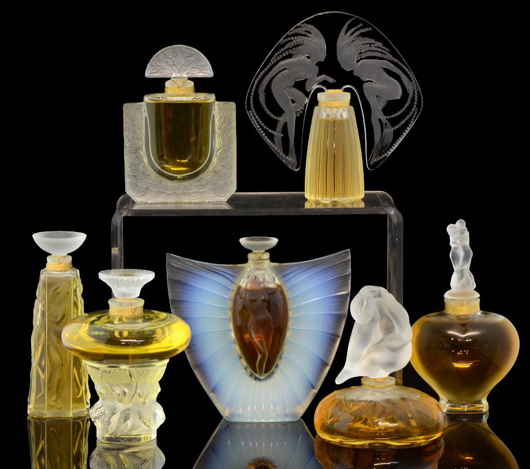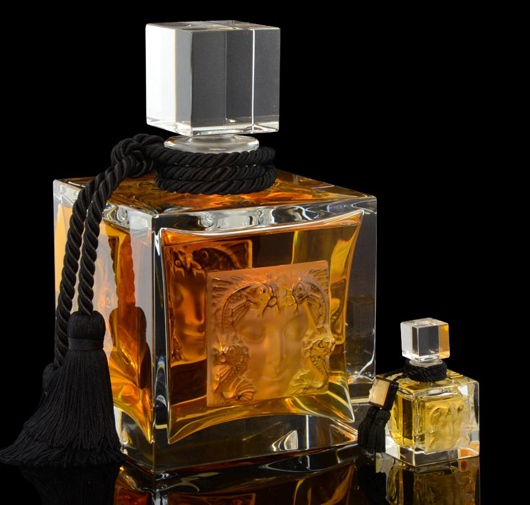
LONDON – Calling all Christmas shoppers: if perfume, bubble bath or aftershave is on your list, remember that the packaging it comes in could be at least as important as the contents.
Once the last bubble in the final bathful has burst, what might once have been discarded would be better put into safekeeping. And if you’re buying for a canny collector, don’t be surprised if she, or he, keeps the contents intact. That’s a true investment strategy.
Two things helped us reach this conclusion: first, we saw a 1998 scent bottle complete with contents with an estimated value of £800-1,200 in a recent sale catalogue. It was made at the factory founded by master French glassmaker Réné Lalique. Then, out on our travels, we found a plastic Rupert Bear bubble bath container — probably some child’s Christmas present 30 years ago – on a collector’s table at an antiques fair. It was priced at £12.
Even the ubiquitous Avon range of toiletries has thrown up some highly collectible and sought-after bottles, notably those in the shape of such things as a golf bag and trolley, Pierrot and Pierrette, rabbit, oil lamp, train, or girl carrying flower basket. There are, no doubt, dozens of others. Although I only have the antiques fair vendor’s word for it, I am told the 1969 vintage Baseball Snoopy aftershave bottle can command a price of £45.
The word perfume comes from the Latin per fumum, “through smoke” and both woman and men have been adorning their bodies with the stuff since ancient Egyptian times.
To please the gods, the Greeks burned aromatic substances in their temples and wrapped their dead in heavily scented shrouds to prepare souls for eternity, or more likely to counteract the smell of decaying flesh.
Pottery scent containers survive from about 600 BC, while the Romans created glass bottles for cosmetic oils. The emperor Nero was a great fan of perfume. He had silver pipes installed in his palace so that his dinner guests could be sprayed with rosewater.
Perfume became popular in Britain as both a cosmetic luxury and for medicinal purposes. The Tudors dusted their hair with sweet-smelling powder to disguise body odor and to drive out lice, while during the Great Plague of 1664-65, pomanders filled with aromatic herbs and creams were carried to ward off germs.
In Renaissance Venice, small highly decorated glass scent bottles were made at the famous Murano glass factories, the most popular being those in colored glass decorated with millefiori and latticino (strands of contrasting coloured glass used as a trelliswork effect). In Bohemia (Germany) during the same period, bottles were made using white glass, decorated with gilding and enamels.
Gold and silver vinaigrettes containing sponges soaked in aromatic oils were popular in Britain but were replaced by pear-shape bottles in the 17th century made from colored and clear glass, enameled copper and gold.
Porcelain bottles made by the Chelsea factory and in neoclassical designs by Josiah Wedgwood were favorites until about 1785.
During the late 18th and throughout the 19th centuries, workers at Battersea, in London and Bilston, near Wolverhampton, and elsewhere in south Staffordshire and Birmingham all copied porcelain scent bottles in copper. The metal was rolled thinly, beaten into shape and then decorated in realistically colored enamels.
The bottles contained glass phials with stoppers to hold the perfume and were decorated with delicately painted flowers, landscapes and classical scenes, the artists Dovey and Hawksford being among the best known.
Novelty perfume bottles made to look like nuts or seashells are popular collectables today, although both porcelain and enamel bottles were faked by Samson in the late 19th century, which can catch out the unwary.
Silver-topped double-ended bottles, in colored glass, cranberry, amber and amethyst also appeared in large numbers, one end for perfume, the other for aromatic vinegar.
English glass makers at Stourbridge in the West Midlands and Nailsea in Bristol produced perfume bottles, the latter being best known for the famous Bristol blue glass.
However, it was the first decade of the 20th century that saw the appearance of the truly decorative glass scent bottle, due largely to innovative Réné Lalique and the “father” of the fragrance industry François Coty. A native of Corsica, Coty arrived in Paris in 1900 with no money but with the entrepreneurial flair to realize the potential of the business.
Until then, perfume had been made using purely natural ingredients by chemists who sold it in plain bottles with no labels only to those wealthy enough to afford it.
Coty spent two years learning the techniques of blending synthetic aromas to achieve the same results for half the price and, using borrowed money, established the House of Coty in 1905.
Lalique, then making a name for himself with stunningly original Art Nouveau glass jewelry and objets de vertu, had a shop nearby. Coty probably saw some of Lalique’s decorative flasks in the shop window and, in 1907, the perfumier commissioned him to design decorative stoppers and labels for his otherwise plain scent bottles.
Sadly, these early bottles are marked with only Coty’s name, although the Lalique designs and gold labels are unmistakable.
Such was their success, Coty commissioned large and impressive deluxe bottles from Lalique which were reserved for only his richest clients. They were intended to be a permanent feature of a lady’s dressing table and could be filled and refilled to special order.
Coty went on to capture the world market. Lalique also capitalized on the venture and quickly established a factory where scent bottles were mass-produced for most of the leading parfumeries.
It was the start of a multimillion-pound industry, the arrival of the age of packaging and the realisation that an elegant and decorative bottle was at least as important as its contents.
Most famous, perhaps, is the Chanel No 5 bottle created by Ernest Beaux in 1921, which has become an icon of 20th-century design and a symbol of elegant luxury everywhere.
The French glassmaking company Baccarat produced perfume bottles for parfumiers like Jean Patou, Elizabeth Arden, Guerlain and Lenthéric, while among other French designers of the period, Marius-Ernest Sabino is best-known, although much of his work was an imitation of Lalique.
At the top end of the collector’s market, 20th-century perfume bottles can fetch many thousands of pounds. At the other end of the scale, those novelty bottles once sold door to door by “Avon Calling” ladies in the Sixties and Seventies can still be picked up for small money.
# # #

ADDITIONAL IMAGES OF NOTE





